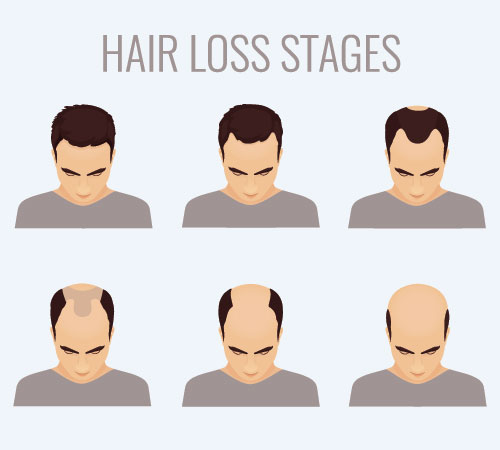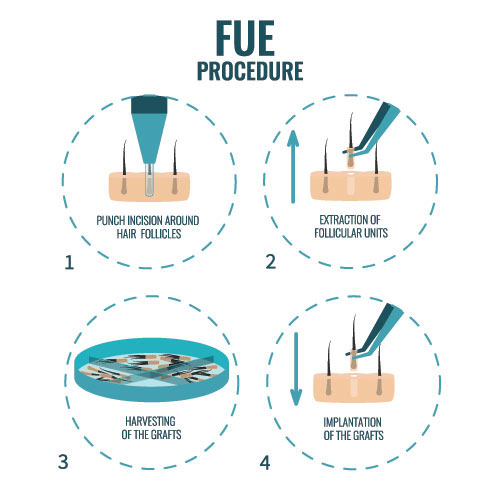This is a sophisticated question and needs a thorough understanding of more and less permanent zones. There’s no zone that is totally permanent, there’s no zone that is totally non-permanent and there’s no distinction line between the two zones.
 This question goes back to the basic principle of how hair transplants work. Scientific studies show that a certain part of the scalp contains more permanent hairs, we use this region as the donor area, and this area is located at the back and sides of the head. More permanent hairs are placed in this region whereas hairs starting from the hairline all the way back to the lower crown – that’s the whole top of the head – contain less permanent hairs.
This question goes back to the basic principle of how hair transplants work. Scientific studies show that a certain part of the scalp contains more permanent hairs, we use this region as the donor area, and this area is located at the back and sides of the head. More permanent hairs are placed in this region whereas hairs starting from the hairline all the way back to the lower crown – that’s the whole top of the head – contain less permanent hairs.
It’s not possible to categorize these hairs or these zones as permanent and non-permanent, it’s not that black and white. The more correct way of describing this is “more permanent zone versus less permanent zone”.
The hairs at the top of the head – which is generally the recipient area in hair surgery – don’t necessarily have to be non-permanent. That means if you fast forward in time like 20-30 years, you may find out that some of those hairs still exist. This will show us that most of the hairs in that region were non-permanent but some of them – may be the minority – were permanent.
Or if you look at the back and sides which are surgically used as the donor area and you fast forward in time like 20-30 years, you may realize that this area first of all shrinks from all four directions, shrinks down from the top – that’s the “receding”, the neck region and the sides go higher – which we call “retrograde alopecia”, that means the hair bearing area gets narrower from the bottom borders and also from the sides. If you see it as a rectangle, this rectangle shrinks from all four directions. So, from that you can tell that although we use that as the donor area, some of that area especially at the borders (the top, bottom and the side borders) are non-permanent. There isn’t a distinct line between donor and recipient areas or there isn’t an exact border between the more permanent and less permanent zones, it’s a gradual transition.
The other thing is that, when we fast forward in time and look at the so-called “donor area” (sides and the back of the head) we will also see that the density also decreases. Let’s say a 70 year old person’s back of the head looks less dense than a 20-year old person’s. So, there will be some hair loss and there will be some miniaturization. Miniaturization is the thinning of hair although they are not permanently lost, they lose in volume and coverage. You will see that this area is less dense than it used to be, it means some of those were lost. That’s why some of those hairs were non-permanent, most of those hairs were probably permanent.
When you harvest hairs from that zone – i.e. the back and sides – if you take hairs from close to the borders you are more likely to take less permanent hairs, so the more you go to the sides, close to the neck and close to the crown and the upper edges, the more non-permanent hairs you may be taking. At the time of the harvest, it may not be possible to exactly tell that these hairs are non-permanent but an experienced surgeon will be able to tell from the patient’s hair loss pattern and from the age that a certain area at the back and sides where hairs exist may actually be less-permanent and he may choose to not take hairs from there whilst an inexperienced person may go and just take those hairs thinking these will be permanent but they may be lost in the long term.
So, surgically speaking, if hairs are taken from the less permanent zone they won’t be permanent or some of them may not be permanent. If most of those hairs are taken from the most permanent zone – it’s actually the middle of that rectangle, the middle of the donor zone – they will be most permanent.
Since the pattern of graft harvesting changes from clinic to clinic or from surgeon to surgeon, the amount of permanent and non-permanent hairs harvested may also change.
 When using the FUE hair transplant method (Follicular Unit Excision), if you take less hairs which means you will be able to take all of those grafts from the middle portion of the donor area, you would end up taking more permanent hairs. If you take a higher number of grafts you will have to take more from the periphery of this zone, which means you will end up taking more less-permanent hairs. If you take more grafts using the FUE hair transplant method that’s not necessarily a good thing because more of those hairs will be taken from the less-permanent zone and you may think that you got more hairs but you may end up within years that some of them get lost because they are not permanent. That’s another surgical factor to be considered regarding how permanent these hairs are.
When using the FUE hair transplant method (Follicular Unit Excision), if you take less hairs which means you will be able to take all of those grafts from the middle portion of the donor area, you would end up taking more permanent hairs. If you take a higher number of grafts you will have to take more from the periphery of this zone, which means you will end up taking more less-permanent hairs. If you take more grafts using the FUE hair transplant method that’s not necessarily a good thing because more of those hairs will be taken from the less-permanent zone and you may think that you got more hairs but you may end up within years that some of them get lost because they are not permanent. That’s another surgical factor to be considered regarding how permanent these hairs are.
Alternatively, if we use the strip method (FUT Hair Transplant) to harvest donor hairs we would typically be taking the grafts from the exact middle portion of the donor area, that means in the strip surgery a finger thick strip between 1 cm to 2 cm in thickness is taken from the very middle of that donor zone, that’s why – in theory – the strip method is more successful in taking the most permanent hairs of the donor zone.
In this article, I tried to answer the question of “whether transplanted hairs are permanent or not?”. “Is a hair transplant permanent?” or “could we lose more hairs in the future?” are other questions that need to be answered separately.
As you can see the “are transplanted hairs permanent?” is a sophisticated question and needs a thorough understanding of more and less permanent zones. There’s no zone that is totally permanent, there’s no zone that is totally non-permanent and there’s no distinction line between the two zones. And also the method of surgery – the ways the grafts are harvested – with the amount of grafts harvested may change the ratio of permanent and non-permanent hairs taken. When we do a hair transplant and harvest donor hairs we take a mixture of permanent and non-permanent hairs. Ideally we would want to take the most number of permanent hairs and the least number of non-permanent hairs. To make sure that more permanent hairs are taken and less non-permanent hairs are taken, we could consider choosing between FUT or FUE and we could consider choosing between taking less units or more units per surgery – less units favors more permanent hairs because it could be taken all from the most permanent zone of the donor area. Therefore the method, how it’s done and the graft number taken may also affect ratio of permanent and non-permanent hairs harvested. We take a mixture of permanent and non-permanent hairs when we do a hair transplant, the better it is planned the more permanent hairs will be transferred.